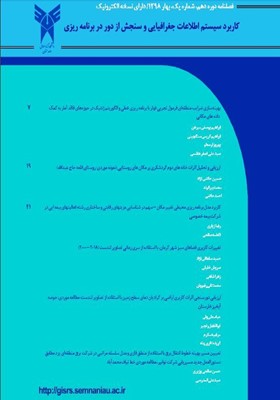ارزیابی و تحلیل اثرات خانه های دوم گردشگری بر مکان های روستایی(نمونه موردی : روستای قلعه حاج عبدالله)
محورهای موضوعی : کاربرد GIS&RS در برنامه ریزی شهریحسین حاتمی نژاد 1 , محمد بیرانوند 2 , احمد حاتمی 3
1 - دانشگاه تهران
2 - دانشگاه تهران
3 - دانشگاه تهران
کلید واژه: گردشگری روستایی, شهرستان بروجرد, خانه های دوم گردشگری, روستای قلعه حاج عبدالله,
چکیده مقاله :
این پژوهش به بررسی اثرات خانه های دوم گردشگری در روستای قلعه حاچ عبدالله پرداخته شده است.روش پژوهش توصیفی- تحلیلی و کتابخانه و مبتنی بر پیمایش میدانی در اشکال پرسشنامه، مشاهده و مصاحبه است.جامعه آماری تمام ساکنان روستای قلعه حاج عبدالله بوده است که در سرشماری سال 1395 برابر 950 نفر بوده اند. برای تخمین حجم نمونه از فرمول کوکران استفاده شده است که مطابق این فرمول تعداد نمونه 381 نفر برآورد شده است. همچنین از روش نمونه گیری تصادفی ساده در سطح روستا استفاده شده است.اطلاعات به دست آمده با استفاده از نرم افزار SPSS و بهره گیری از آزمون T تک نمونه ای مورد تجزیه و تحلیل قرار گرفتند. نتایج به دست آمده نشان داد که اثرات خانه های دوم گردشگری در ابعاد اجتماعی، اقتصادی و کالبدی- زیست محیطی در بردارنده نقاط مثبت و منفی و متضادی بوده است. که در بعد اجتماعی اثرات مثبت آن در قالب افزایش امنیت اجتماعی و کاهش مهاجرت های ساکنین روستا بوده است. و همچنین اثرات منفی همچون افزایش سبک زندگی شهری، نابودی آداب رسوم روستا، گسست اجتماعی را در بین ساکنین روستا در برداشته است.همچنین در بعد اقتصادی به مراتب اثرات بهتر از ابعاد اجتماعی و کالبدی بوده است. به گونه ای که ساکنان اظهارکرده اند با ایجاد و گسترش خانه های دوم وضعیت اشتغال و درآمد روستا بهبود یافته است و با افزایش داد و ستد اقتصادی در منطقه و تقویت پایه اقتصادی روستا زمینه اشتغال ساکنان فراهم شده و از شدت مهاجرت های روستاشهری کاسته شده است.ودرآخر از نظر بعدکالبدی- زیست محیطی اثرات خانه های دوم بصورت گسترش بافت مسکونی روستا و رشد قارچ گونه خانه های دوم در بین مزارع و باغات منطقه که پیامدهای آن در تغییر کاربری اراضی و تغییر چشم انداز روستا از یک حوزه کشاورزی به یک حوزه مصنوع با واحدهای ویلایی بوده است.
in this research, the effects of the second homes of tourism in Ghaleh Haj Abdullah village have been investigated. The method of this descriptive-analytical and library research is based on field survey in forms of questionnaire, observation and interview. Statistical population of all residents The village of Ghaleh was Haj Abdullah, which was 950 in the census in 1395. For estimation of the sample size, the Cochran formula has been used, according to this formula, the number of samples is 381 people. Also, simple random sampling method was used in the village level. Data were analyzed by SPSS software using T-test. The results showed that the effects of second homes in social, economic and physical-environmental dimensions have been positive, negative and controversial. In the social dimension, its positive effects include increasing social security and reducing the immigration of inhabitants The village has been. As well as negative effects such as increasing urban lifestyle, eliminating the customs of rural customs, social disruption has been among the villagers. Also, in the economic aspect, it has had far more effects than social and physical dimensions. Residents have stated that by creating and expanding second homes, the situation of employment and income of the village has improved, and with the increase of economic activity in the region and the strengthening of the rural economy, the employment of the residents has been provided and the intensity of the rural population has decreased. The latter, in terms of environmental and environmental aspects, have the effects of second homes as an extension of the residential tissue of the village and the growth of the second species of mussels in the fields and gardens of the region, which have implications for land use change and rural landscape change from an agricultural domain to an artifact With villa units.
_||_


